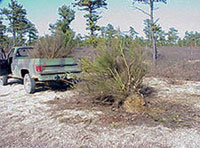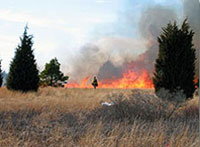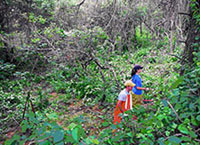Invasives
 The Camp Edwards Training Site, of the Massachusetts Army National Guard, consists of nearly 15,000 acres of undeveloped land, and is located on upper Cape Cod. Traditionally this natural community has had few invasives. With the increased development of Cape Cod in the past 20 years, and more recently, the groundwater restoration activities, invasives have been increasingly observed along roadsides and remediation sites. Locations of most roadside and remediation site invasives have been mapped with GPS units. With this spatial information, we can analyze what invasives we have, in what concentrations we have them, and where they are located. This is helping us to choose the right tool (stump and paint, injection, prescribed fire, etc.) to manage invasives in order to improve the natural community and mission-scape at Camp Edwards.
The Camp Edwards Training Site, of the Massachusetts Army National Guard, consists of nearly 15,000 acres of undeveloped land, and is located on upper Cape Cod. Traditionally this natural community has had few invasives. With the increased development of Cape Cod in the past 20 years, and more recently, the groundwater restoration activities, invasives have been increasingly observed along roadsides and remediation sites. Locations of most roadside and remediation site invasives have been mapped with GPS units. With this spatial information, we can analyze what invasives we have, in what concentrations we have them, and where they are located. This is helping us to choose the right tool (stump and paint, injection, prescribed fire, etc.) to manage invasives in order to improve the natural community and mission-scape at Camp Edwards.One issue we face is the spread of invasive plant species. This is due to encroachment, habitat fragmentation, and disturbance. The military disturbs the habitat through training, but most of the negative impacts to the ecosystem are associated with the groundwater cleanup. We work with the ground water cleanup program to minimize impacts such as habitat loss and fragmentation from monitoring well installation, and invasives hitch-hiking on vehicles associated with the program.
The daunting task of inventorying the exotics and invasives of Camp Edwards could not have been completed without the help of The Senior Environment Corps. of Cape Cod and the Islands. With their help, we were able to inventory nearly all of the 120 mile road system of Camp Edwards. Volunteers were trained on how to identify exotic plant species of concern through presentation and field work. At the start of the day, volunteers were given a training area to monitor for invasives. They would then fill out the location of an exotic on a form, using the template as seen below.
The Impact Area Groundwater Office at Camp Edwards has monitored the 700+ monitoring well pads since 2002 for vegetative cover. Data on invasives were queried from their database.
In addition to this data, we monitor 224, 100 meter point intercept and belt transects, within the natural communities of Camp Edwards. These plots are monitored using annual field crews. This data is more detailed for location, and gives us a better idea of the health of the habitat. Also if exotic plants are found elsewhere they are recorded using a GPS.
 Several methods of eradication have been employed. For roadsides, mowing and cutting are the most time and cost effective. On Camp Edwards, it is necessary to maintain road edges and fire breaks for safety reasons. Prescribed fire is also used to maintain a healthy ecosystem and eradicate invasives. These are fire dependant ecosystems and need fire to thrive. The goal is to burn 1,000 acres per year. Depending on the time of the year the fire is conducted, certain exotics can be controlled. For the more stubborn invasives, the method of stump and paint using Glyphosate, and hand pulling is utilized.
Several methods of eradication have been employed. For roadsides, mowing and cutting are the most time and cost effective. On Camp Edwards, it is necessary to maintain road edges and fire breaks for safety reasons. Prescribed fire is also used to maintain a healthy ecosystem and eradicate invasives. These are fire dependant ecosystems and need fire to thrive. The goal is to burn 1,000 acres per year. Depending on the time of the year the fire is conducted, certain exotics can be controlled. For the more stubborn invasives, the method of stump and paint using Glyphosate, and hand pulling is utilized. The Senior Environmental Corp. spent two years and nearly 1000 hours inventorying the Camp Edwards 120 mile road system. The following is a list of invasives from the most to least abundant:
- Spotted knapweed
- Shrub Honeysuckle
- Asiatic bittersweet
- Multi Flora Rose
- Crown vetch-75
- Japanese Barberry
The Impact Area Groundwater Office surveys of well pads resulted in finding a several locations of Scotch broom and Japanese knotweed that have since been eradicated using hand pulling and injection of Glyphosphate
 The field crews survey approximately 60 plots per year on Camp Edwards. These plots are mainly located in undisturbed sites within the natural communities of Camp Edwards. Very few invasive plants have been found in the Reserve since monitoring began in 1994. Only a few honeysuckle and Japanese barberry were found. Most eradication efforts are needed in the Cantonment area grasslands.
The field crews survey approximately 60 plots per year on Camp Edwards. These plots are mainly located in undisturbed sites within the natural communities of Camp Edwards. Very few invasive plants have been found in the Reserve since monitoring began in 1994. Only a few honeysuckle and Japanese barberry were found. Most eradication efforts are needed in the Cantonment area grasslands.The results of the initial surveys indicate that the roadsides and remediation sites contain the most invasives. The roads bordering housing developments are where most of the invasive plant species occur. Monitoring well pads themselves, contain many exotics and a few dangerous invasives. The interior habitat on the other hand, is nearly free of invasive plants. Thus, the well pads need to be monitored yearly to catch these invasives and eradicate them before they get out of control.
The road shoulders that have been mowed, have resulted in a heath-like habitat. The woody invasives such as Autumn olive and Multi flora rose do not seem to be reoccurring. Instead huckleberry and scrub oak are the main components. Repeated mowing to promote a heath-like system is the goal.
Prescribed fire works well to promote a healthy ecosystem that naturally hinders exotics. However, some invasives such as Japanese honeysuckle requires repeated burning or additional stump and paint treatments to control.
Results to date:
- Stump and Paint, 2003 - present - Japanese barberry-124; Autumn olive-1945; Scotch broom-17; Purple loosetrife-1; Japanese knotweed-75; Phragmites-10; Honeysuckle-3789; Bittersweet-455; multi flora rose-236
- Road shoulder maintenance - cleared 10-20' on either side of the roadway 2003 to present: 52 miles
- Prescribed Fire - 2003-present: 1294 acres
Not any one technique works alone. Monitoring is the key to success of invasive control. Techniques have to be evaluated on a site by site basis, taking into consideration funding, personnel, encroachment issues, plant species, impacts to rare species and or ecosystems as a whole. At Camp Edwards, our goal is diligence in monitoring and control of invasive plants. It is a battle we are fighting from our boarders through encroachment, and from fragmentation within and through groundwater restoration activities.